A Comprehensive Evaluation of Key Tropospheric Parameters from ERA5 and MERRA-2 Reanalysis Products Using Radiosonde Data and GNSS Measurements
Abstract
:1. Introduction
2. Data and Methodology
2.1. Data Description
2.1.1. Reanalysis Products
2.1.2. GNSS Data
2.1.3. Radiosonde Data
2.2. Methods
2.2.1. Deriving ZTD, ZHD, ZWD, and Tm from ERA5 and MERRA-2 Surface- and Pressure-Level Data
2.2.2. Calculating ZTD, ZHD, ZWD, and Tm Using ERA5 and MERRA-2 Data at Radiosonde and GNSS Stations
3. Results
3.1. Comparisons between ERA5/MERRA-2 ZTD and GNSS ZTD
3.2. Evaluations of the ZHD, ZWD, and Tm Derived from MERRA-2 and ERA5 by Radiosonde Data
4. Conclusions
Author Contributions
Funding
Data Availability Statement
Acknowledgments
Conflicts of Interest
References
- Hofmeister, A.; Bohm, J. Application of ray-traced tropospheric slant delays to geodetic VLBI analysis. J. Geod. 2017, 91, 945–964. [Google Scholar] [CrossRef] [Green Version]
- Mendes, V.B.; Prates, G.; Pavlis, E.C.; Pavlis, D.E.; Langley, R.B. Improved mapping functions for atmospheric refraction correction in SLR. Geophys. Res. Lett. 2002, 29, 51–53. [Google Scholar] [CrossRef] [Green Version]
- Kinoshita, Y.; Shimada, M.; Furuya, M. InSAR observation and numerical modeling of the water vapor signal during a heavy rain: A case study of the 2008 Seino event, central Japan. Geophys. Res. Lett. 2013, 40, 4740–4744. [Google Scholar] [CrossRef]
- Hobiger, T.; Ichikawa, R.; Koyama, Y.; Kondo, T. Fast and accurate ray-tracing algorithms for real-time space geodetic applications using numerical weather models. J. Geophys. Res. Atmos. 2008, 113. [Google Scholar] [CrossRef]
- Askne, J.; Nordius, H. Estimation of tropospheric delay for microwaves from surface weather data. Radio Sci. 1987, 22, 379–386. [Google Scholar] [CrossRef]
- Ning, T.; Wang, J.; Elgered, G.; Dick, G.; Wickert, J.; Bradke, M.; Sommer, M.; Querel, R.; Smale, D. The uncertainty of the atmospheric integrated water vapour estimated from GNSS observations. Atmos. Meas. Tech. 2016, 9, 79–92. [Google Scholar] [CrossRef] [Green Version]
- Lu, C.; Zus, F.; Heinkelmann, R.; Dick, G.; Ge, M.; Wickert, J.; Schuh, H. Tropospheric delay parameters from numerical weather models for muulti-GNSS precise positioning. Atmos. Meas. Tech. 2016, 9, 5965–5973. [Google Scholar] [CrossRef] [Green Version]
- Lu, C.; Li, X.; Zus, F.; Keinkelmann, R.; Dick, G.; Ge, M.; Wickert, J.; Schuh, H.; Wickert, J.; Schuh, H. Improving BeiDou real-time precise point positioning with numerical weather models. J. Geod. 2017, 91, 1019–1029. [Google Scholar] [CrossRef]
- Yao, Y.; Peng, W.; Xu, C.; Cheng, S. Enhancing real-time precise point positioning with zenith troposphere delay products and the determination of corresponding tropospheric stochastic models. Geophys. J. Int. 2017, 208, 1217–1230. [Google Scholar] [CrossRef]
- Pany, T.; Pesec, P.; Stangl, G. Elimination of tropospheric path delays in GPS observations with the ECMWF numerical weather model. Phys. Chem. Earth Part A Solid Earth Geod. 2001, 26, 487–492. [Google Scholar] [CrossRef]
- Bromwich, D.H.; Wang, S.H. Evaluation of the NCEP-NCAR and ECMWF15-and 40-yr reanalyzes using radiosonde data from two independent Arctic field experiments. Mon. Weather rev. 2005, 133, 3562–3578. [Google Scholar] [CrossRef]
- Bohm, J.; Moller, G.; Schindelegger, M.; Pain, G.; Weber, R. Development of an improved empirical model for slant delays in the troposphere (GPT2w). GPS Solut. 2015, 19, 433–441. [Google Scholar] [CrossRef] [Green Version]
- Landskron, D.; Bohm, J. VMF3/GPT3: Refined discrete and empirical troposphere mapping functions. J. Geod. 2018, 92, 349–360. [Google Scholar] [CrossRef]
- Schuler, T. The TropGrid2 standard tropospheric correction model. GPS Solut. 2014, 18, 123–131. [Google Scholar] [CrossRef]
- Yao, Y.; Xu, C.; Shi, J.; Cao, N.; Zhang, B.; Yang, J. ITG: A new global GNSS tropospheric correction model. Sci. Rep. 2015, 5, 10273. [Google Scholar] [CrossRef] [Green Version]
- Huang, L.K.; Liu, L.L.; Chen, H.; Jiang, W.P. An improved atmospheric weighted mean temperature model and its impact on GNSS precipitable water vapor estimates for China. GPS Solut. 2019, 23, 1–16. [Google Scholar] [CrossRef]
- Huang, L.K.; Jiang, W.P.; Liu, L.L.; Chen, H.; Ye, S.R. A new global grid model for the determination of atmospheric weighted mean temperature in GPS precipitable water vapor. J. Geod. 2019, 93, 159–176. [Google Scholar] [CrossRef]
- Zhang, W.; Zhang, H.; Liang, H.; Lou, Y.; Cai, Y.; Cao, Y.; Zhou, Y.; Liu, w. On the suitability of ERA5 in hourly GPS precipitable water vapor retrieval over China. J. Geod. 2019, 93, 1897–1909. [Google Scholar] [CrossRef]
- Mateus, P.; Catalão, J.; Mendes, V.B.; Nico, G. An ERA5-Based Hourly Global Pressure and Temperature (HGPT) Model. Remote Sens. 2020, 12, 1098. [Google Scholar] [CrossRef] [Green Version]
- Li, J.Y.; Zhang, B.; Yao, Y.B.; Liu, L.L.; Sun, Z.Y.; Yan, X. A refined regional model for estimating pressure, temperature, and water vapor pressure for geodetic applications in China. Remote Sens. 2020, 12, 1713. [Google Scholar] [CrossRef]
- Sun, Z.; Zhang, B.; Yao, Y. An ERA5-based model for estimating tropospheric delay and weighted mean temperature over China with improved spatiotemporal resolutions. Earth Space Sci. 2019, 6, 1926–1941. [Google Scholar] [CrossRef]
- Vedel, H.; Mogensen, K.S.; Huang, X.Y. Calculation of zenith delays from meteorological data comparison of NWP model, radiosonde and GPS delays. Phys. Chem. Earth Part A Solid Earth Geod. 2001, 26, 497–502. [Google Scholar] [CrossRef]
- Zhou, Y.; Lou, Y.; Zhang, W.; Kuang, C.; Liu, W.; Bai, J. Improved performance of ERA5 in global tropospheric delay retrieval. J. Geod. 2020, 94, 103. [Google Scholar] [CrossRef]
- Hersbach, H.; de Rosnay, P.; Bell, B.; Schepers, D.; Simmons, A.; Soci, C.; Abdalla, S.; Alonso-Balmaseda, M.; Balsamo, G.; Bechtold, P.; et al. Operational global reanalysis: Progress, future directions and Synergies with NWP. ERA Rep. Ser. 2018, 27. [Google Scholar] [CrossRef]
- Albergel, C.; Dutra, E.; Munier, S.; Calvet, J.C.; Munoz-Sabater, J.; de Rosnay, P.; Balsamo, G. ERA5 and ERA-Interim driven ISBA land surface model simulations: Which one performs better? Hydrol. Earth Syst. Sci. 2018, 22, 3515–3532. [Google Scholar] [CrossRef] [Green Version]
- Molod, A.; Takacs, L.; Suarez, M.; Bacmeister, J. Development of the GEOS-5 atmospheric general circulation model: Evolution from MERRA to MERRA2. Geosci. Model Dev. 2015, 8, 1339–1356. [Google Scholar] [CrossRef] [Green Version]
- Gelaro, R.; Mccarty, W.; Suárez, M.; Todling, R.; Zhao, B. The modern-era retrospective analysis for research and applications, Version 2 (MERRA-2). J. Clim. 2017, 30, 5419–5454. [Google Scholar] [CrossRef]
- Jiang, C.; Xu, T.; Wang, S.; Nie, S.; Sun, Z. Evaluation of zenith tropospheric delay derived from ERA5 data over China using GNSS observations. Remote Sens. 2020, 12, 663. [Google Scholar] [CrossRef] [Green Version]
- Byun, S.H.; Bar-Sever, Y.E. A new type of troposphere zenith path delay product of the international GNSS service. J. Geod. 2009, 83, 367–373. [Google Scholar] [CrossRef] [Green Version]
- Yao, Y.; Xu, C.; Zhang, B.; Cao, N. GTm-III: A new global empirical model for mapping zenith wet delays onto precipitable water vapour. Geophys. J. Int. 2014, 197, 202–212. [Google Scholar] [CrossRef] [Green Version]
- Zhang, H.; Yuan, Y.; Li, W.; Zhang, B. A real-time precipitable water vapor monitoring system using the national GNSS network of China: Method and preliminary results. IEEE J. Sel. Top. Appl. Earth Obs. Remote Sens. 2019, 12, 1587–1598. [Google Scholar] [CrossRef]
- Wang, J.; Zhang, L. Climate applications of a global, 2-hourly atmospheric precipitable water dataset derived from IGS tropospheric products. J. Geod. 2009, 83, 209–217. [Google Scholar] [CrossRef] [Green Version]
- Bevis, M.; Businger, S.; Herring, T.; Rocken, C.; Anthes, R.; Ware, R. GPS meteorology’ remote sensing of atmospheric water vapor using the global positioning system. J. Geophys. Res. 1992, 97, 15787–15801. [Google Scholar] [CrossRef]
- Thayer, G. An improved equation for the radio refractive index of air. Radio Sci. 1974, 9, 803–807. [Google Scholar] [CrossRef]
- Davis, J.L.; Herring, T.A.; Shapiro, I.I.; Rogers, A.E.E.; Elgered, G. Geodesy by radio interferometry: Effects of atmospheric modeling errors on estimates of baseline length. Radio Sci. 1985, 20, 1593–1607. [Google Scholar] [CrossRef]
- Saastamioinen, J. Contributions to the theory atmospheric refraction, Part II refraction corrections in satellite Geodesy. Bull. Geo. 1972, 105, 279–298. [Google Scholar] [CrossRef]
- Chen, Q.; Song, S.; Heise, S.; Liou, Y.; Zhu, W.; Zhao, J. Assessment of ZTD derived from ECMWF/NCEP data with GPS ZTD over China. GPS Solut. 2011, 15, 415–425. [Google Scholar] [CrossRef]
- Pavlis, N.K.; Holmes, S.A.; Kenyon, S.C.; Factor, J.K. The development and evaluation of the Earth Gravitational Model 2008 (EGM2008). J. Geophys. Res. 2012, 117. [Google Scholar] [CrossRef] [Green Version]
- Huang, L.K.; Guo, L.J.; Liu, L.L.; Chen, H.; Chen, J.; Xie, S.F. Evaluation of the ZWD/ZTD values derived from MERRA-2 global reanalysis products using GNSS observations and radiosonde data. Sensors 2020, 20, 6440. [Google Scholar] [CrossRef] [PubMed]
- Janssen, V.; Ge, L.; Rizos, C. Tropospheric corrections to SAR interferometry from GPS observations. GPS Solut. 2004, 8, 140–151. [Google Scholar] [CrossRef] [Green Version]
- Huang, L.; Mo, Z.; Liu, L.; Zeng, Z.; Chen, J.; Xiong, S.; He, H. Evaluation of hourly PWV products derived from ERA5 and MERRA-2 over the Tibetan Plateau using ground based GNSS observations by two enhanced models. Earth Space Sci. 2021, 8, e2020EA001516. [Google Scholar] [CrossRef]
- Yao, Y.; Xu, X.; Xu, C.; Peng, W.; Wan, Y. GGOS tropospheric delay forecast product performance evaluation and its application in real-time PPP. J. Atmos. Sol. Terr. Phys. 2018, 175, 1–17. [Google Scholar] [CrossRef]
- Nikolaidou, T.; Balidakis, K.; Nievinski, F.G.; Santos, M.C.; Schuh, H. Impact of different NWM-derived mapping functions on VLBI and GPS analysis. Earth Planets Space 2018, 70, 1–16. [Google Scholar] [CrossRef] [Green Version]
- Yao, Y.; Sun, Z.; Xu, C. Establishment and Evaluation of a New Meteorological Observation-Based Grid Model for Estimating Zenith Wet Delay in Ground-Based Global Navigation Satellite System (GNSS). Remote Sens. 2018, 10, 1718. [Google Scholar] [CrossRef] [Green Version]
- Zhang, H.; Yuan, Y.; Li, W.; Ou, J.; Li, Y.; Zhang, B. GPS PPP-derived precipitable water vapor retrieval based on Tm/Ps from multiple sources of meteorological data sets in china. J. Geophys. Res. 2017, 122, 4165–4183. [Google Scholar] [CrossRef]
- Zhai, P.; Eskridge, R.E. Atmospheric water vapor over China. J. Clim. 1997, 10, 2643–2652. [Google Scholar] [CrossRef]
- Tang, C.; Li, X.; Li, J.; Dai, C.; Deng, L.; Wei, H. Distribution and trends of the cold-point troposphere over China from 1979 to 2014 based on radiosonde dataset. Atmos. Res. 2017, 193, 1–9. [Google Scholar] [CrossRef]


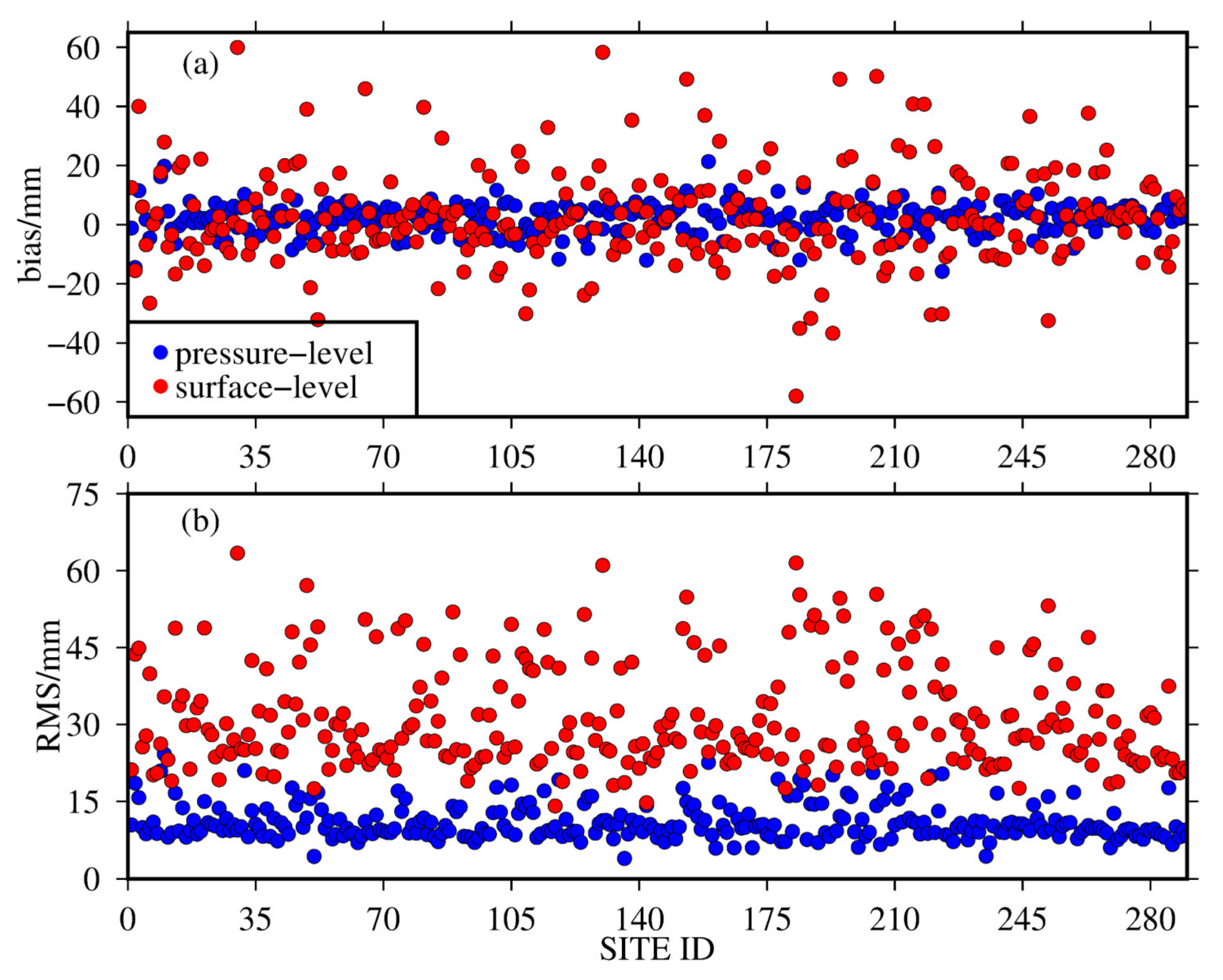
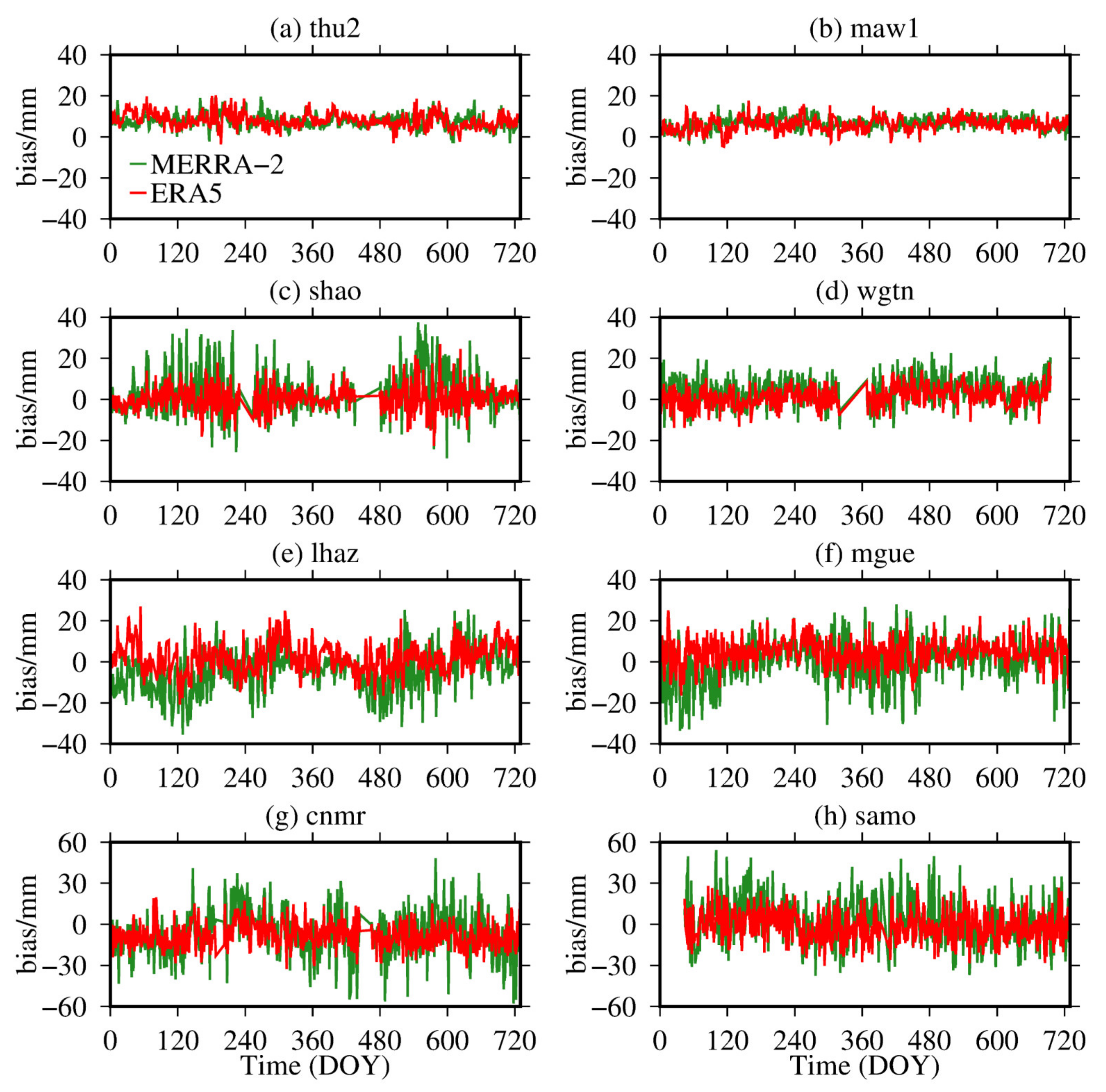

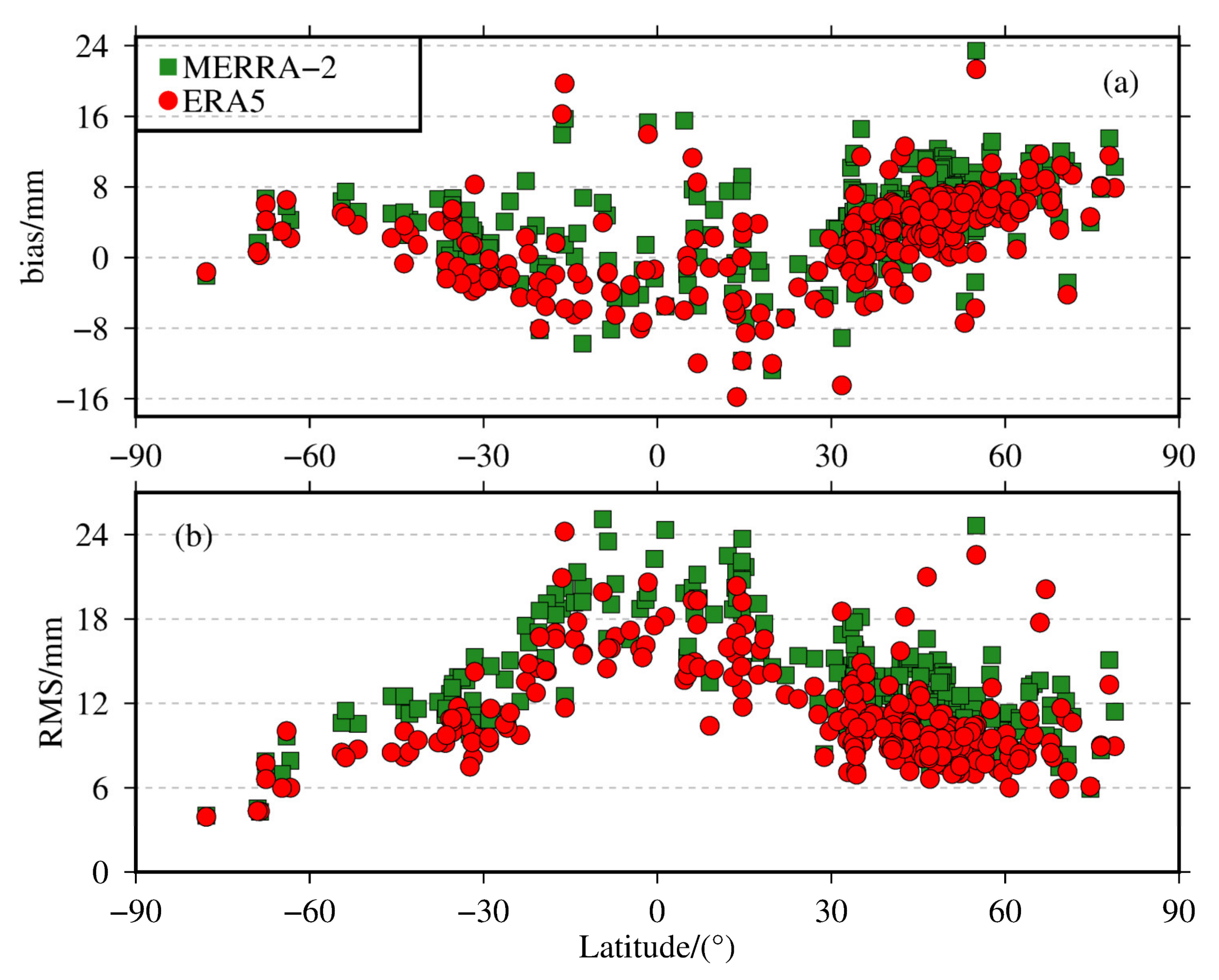
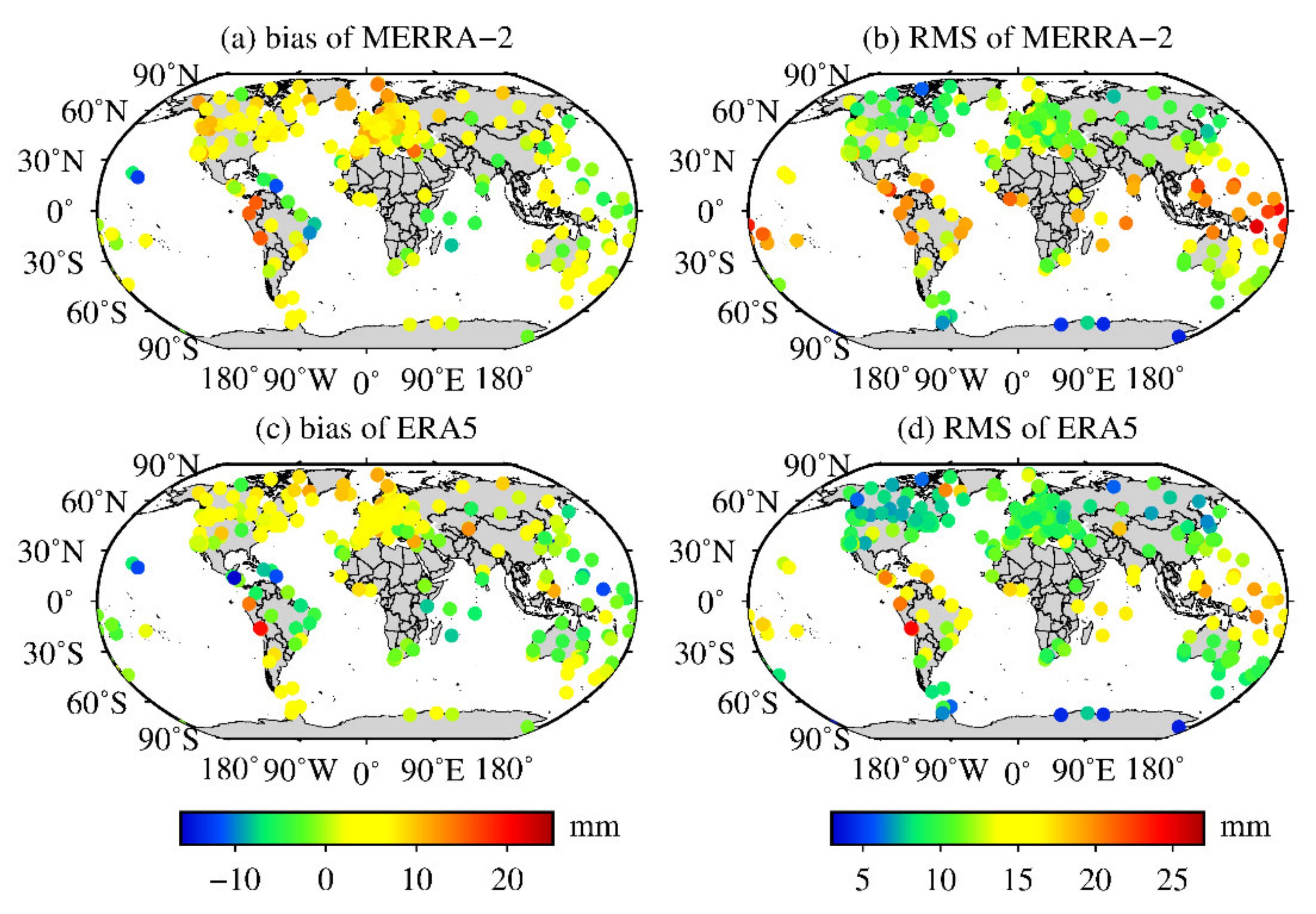
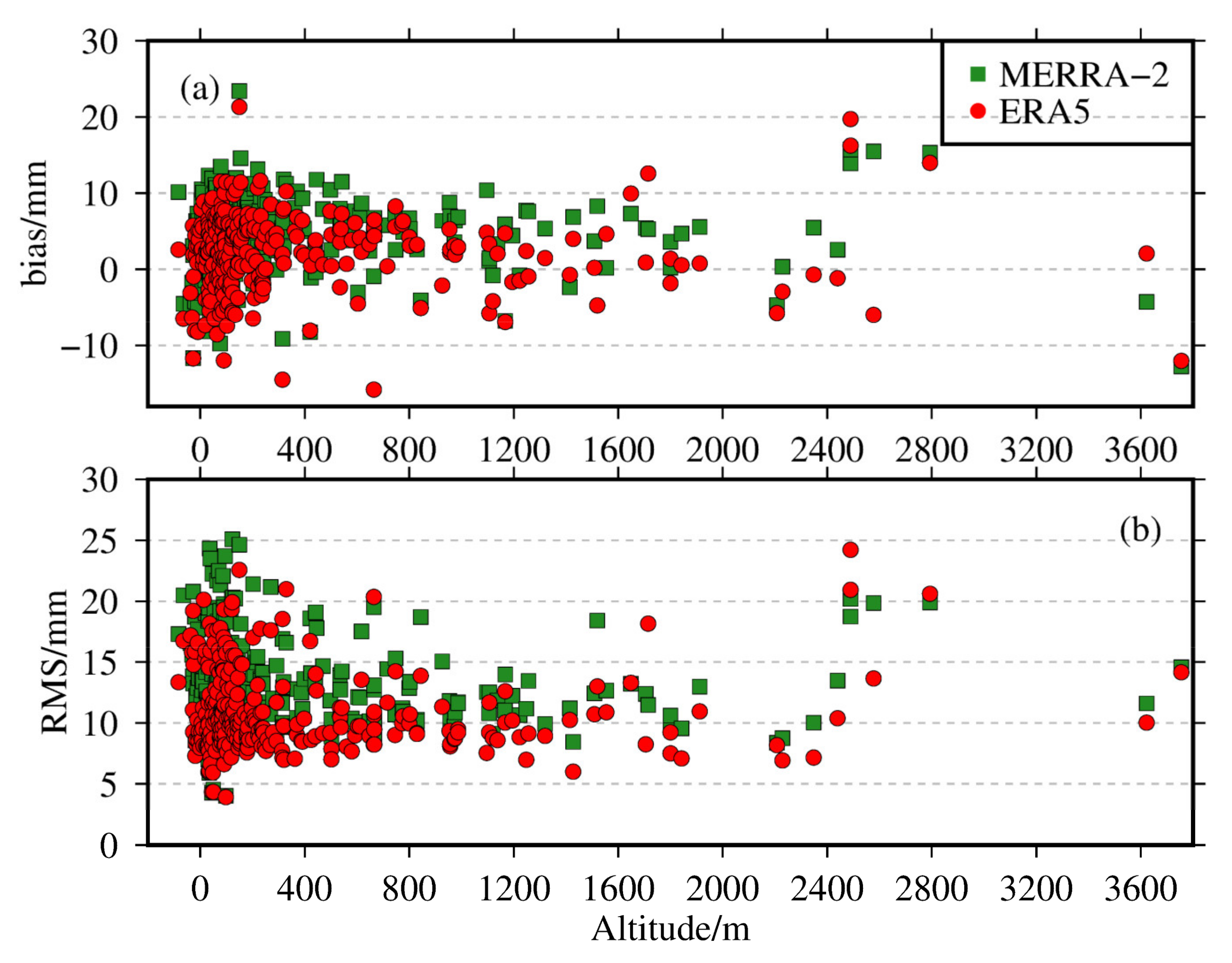
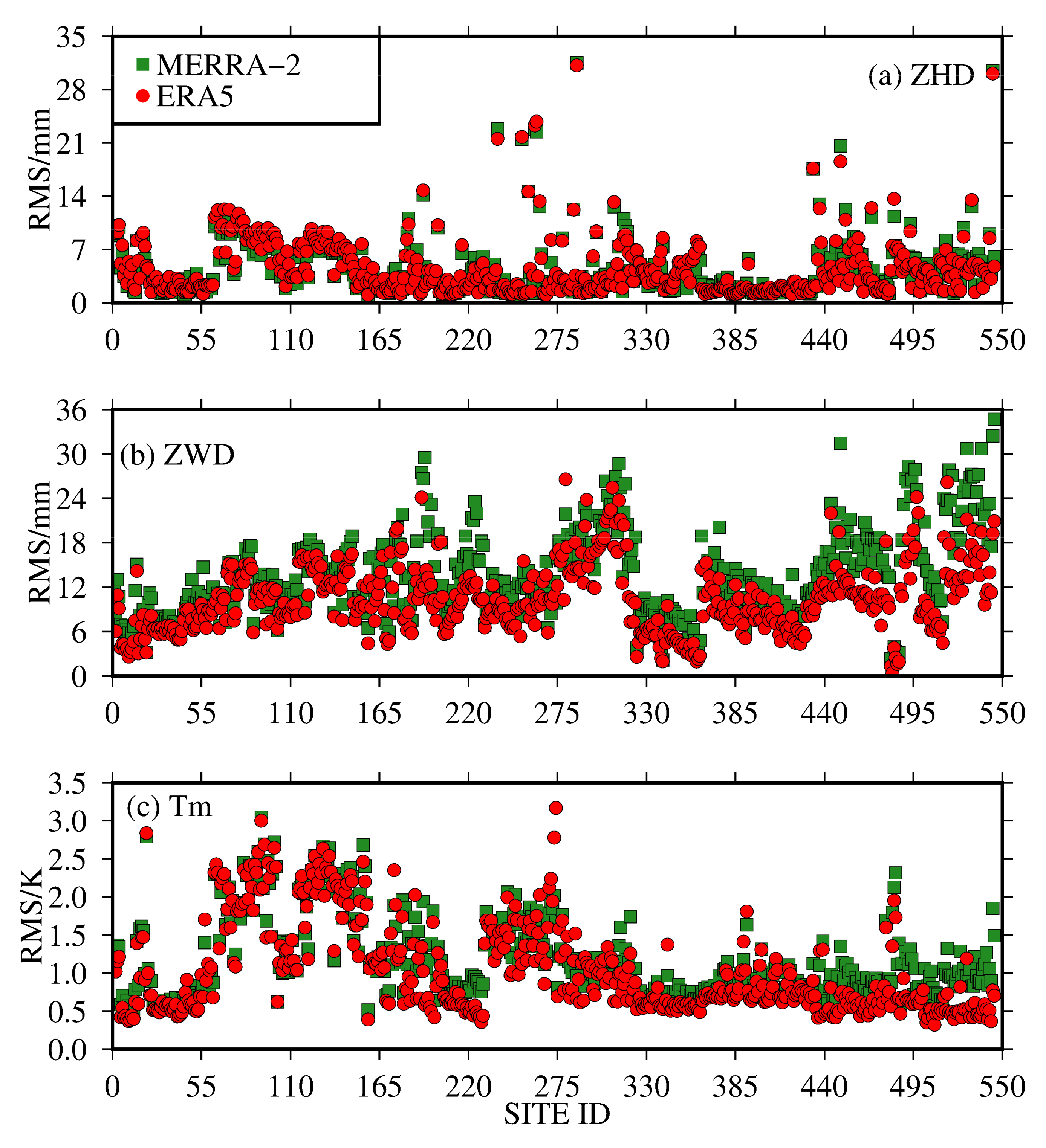
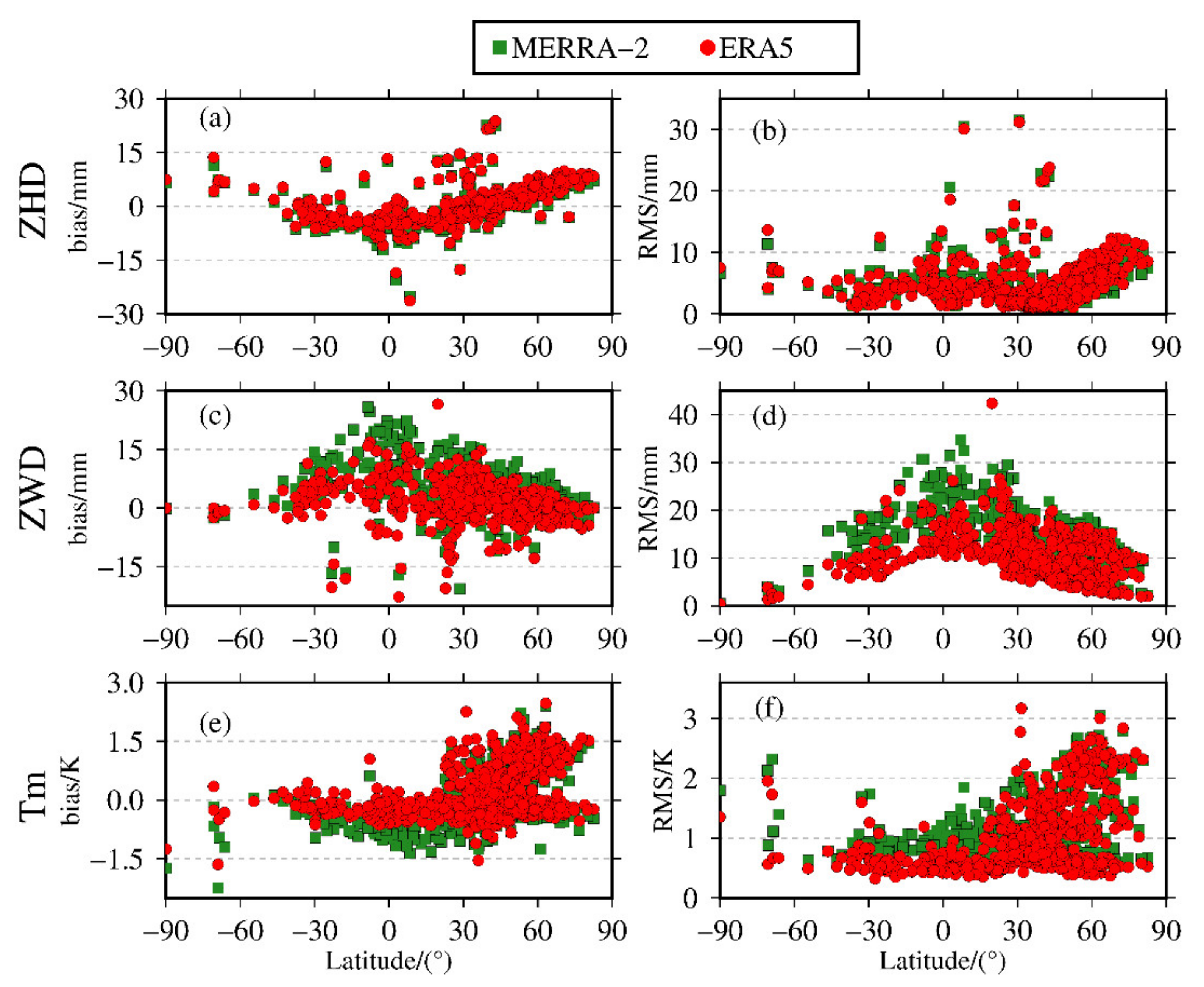
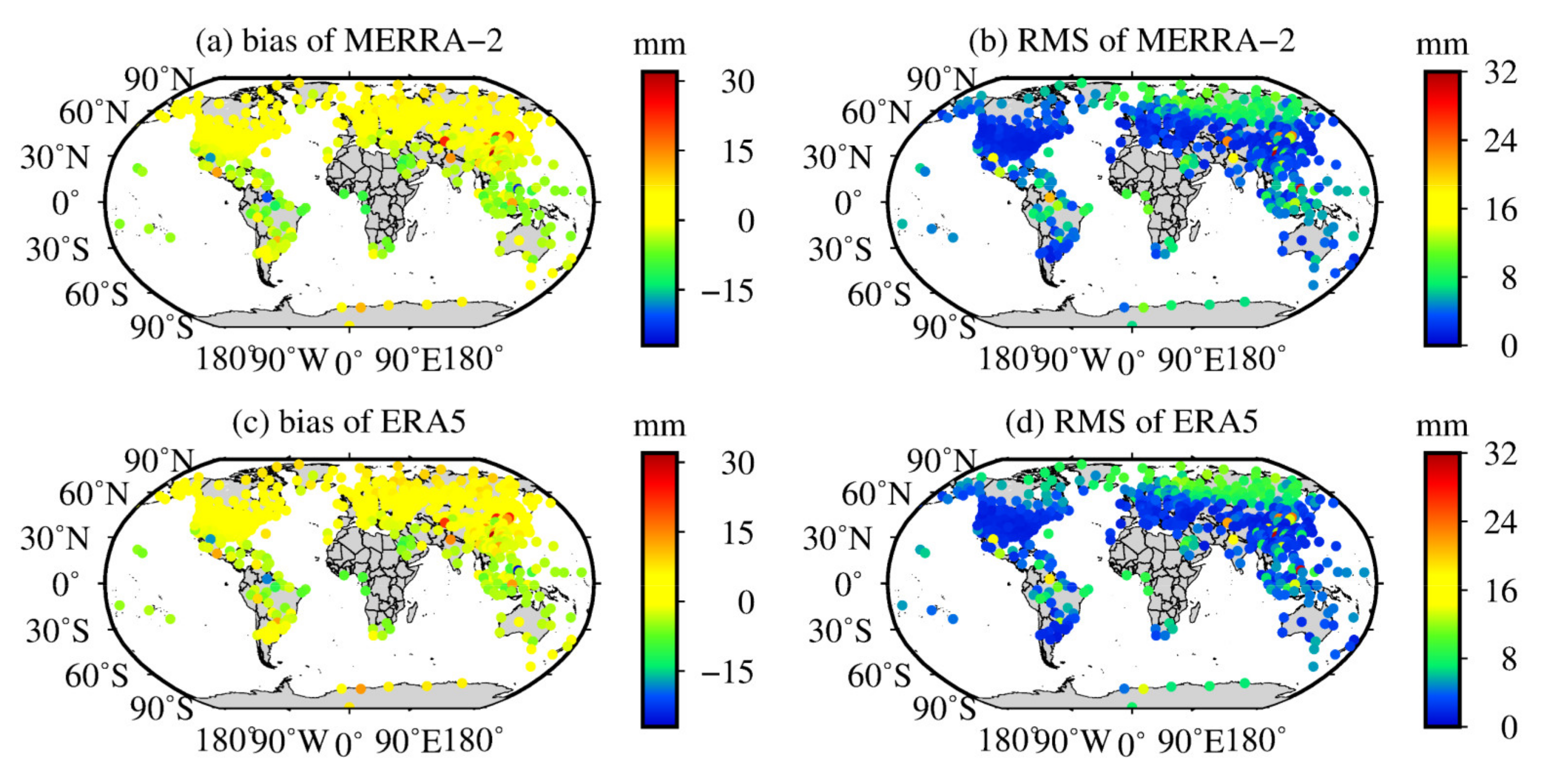
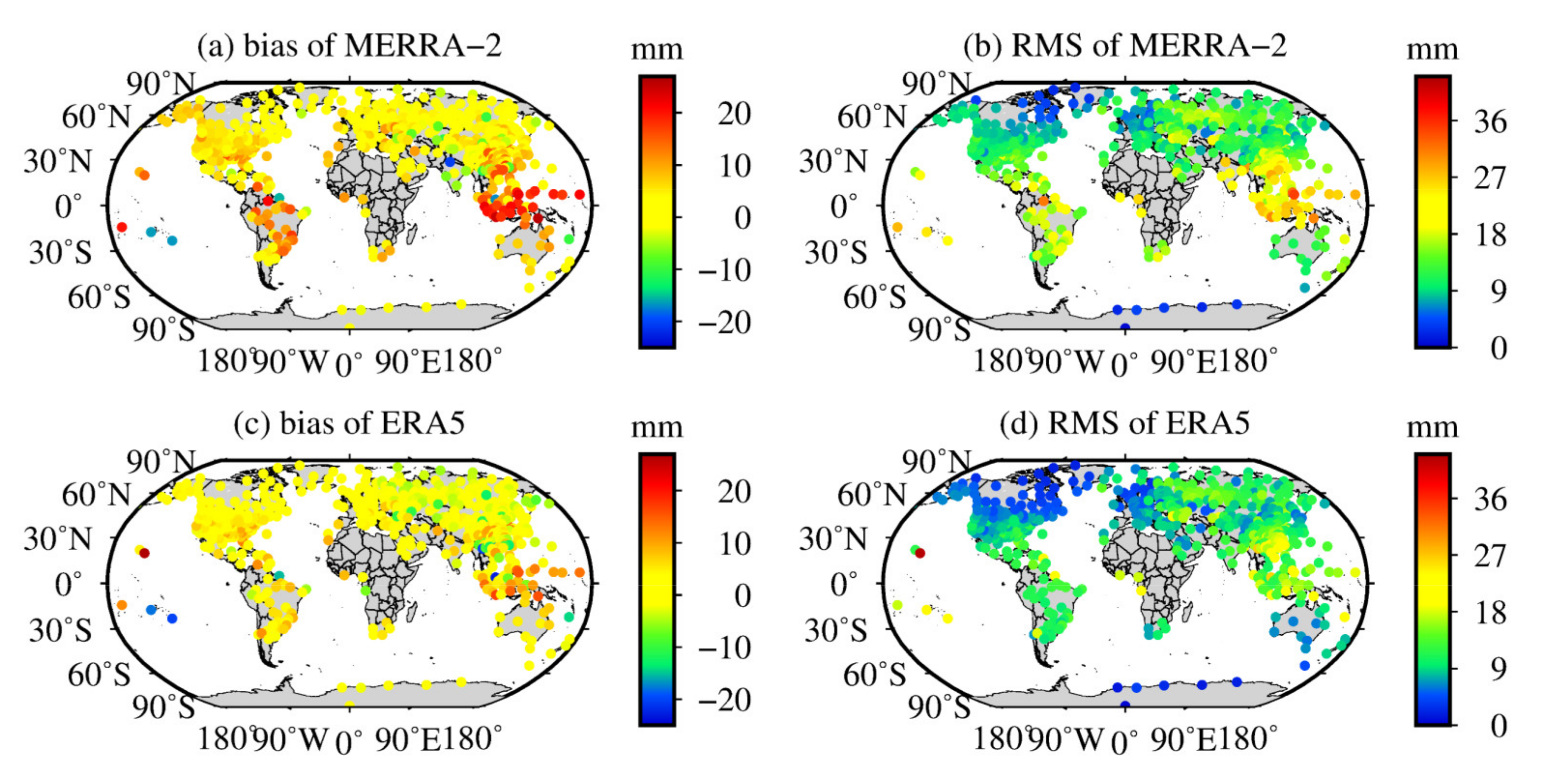
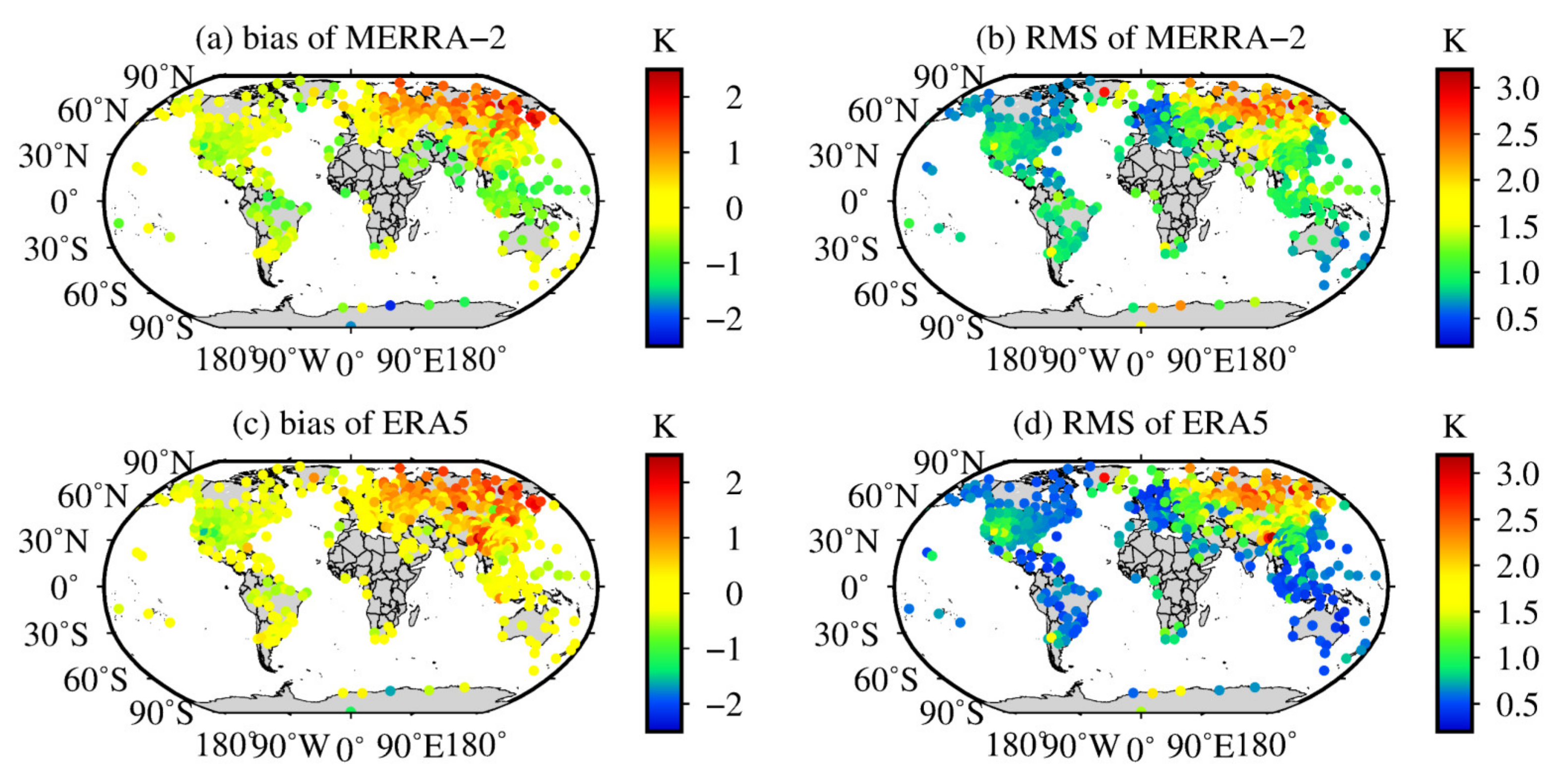
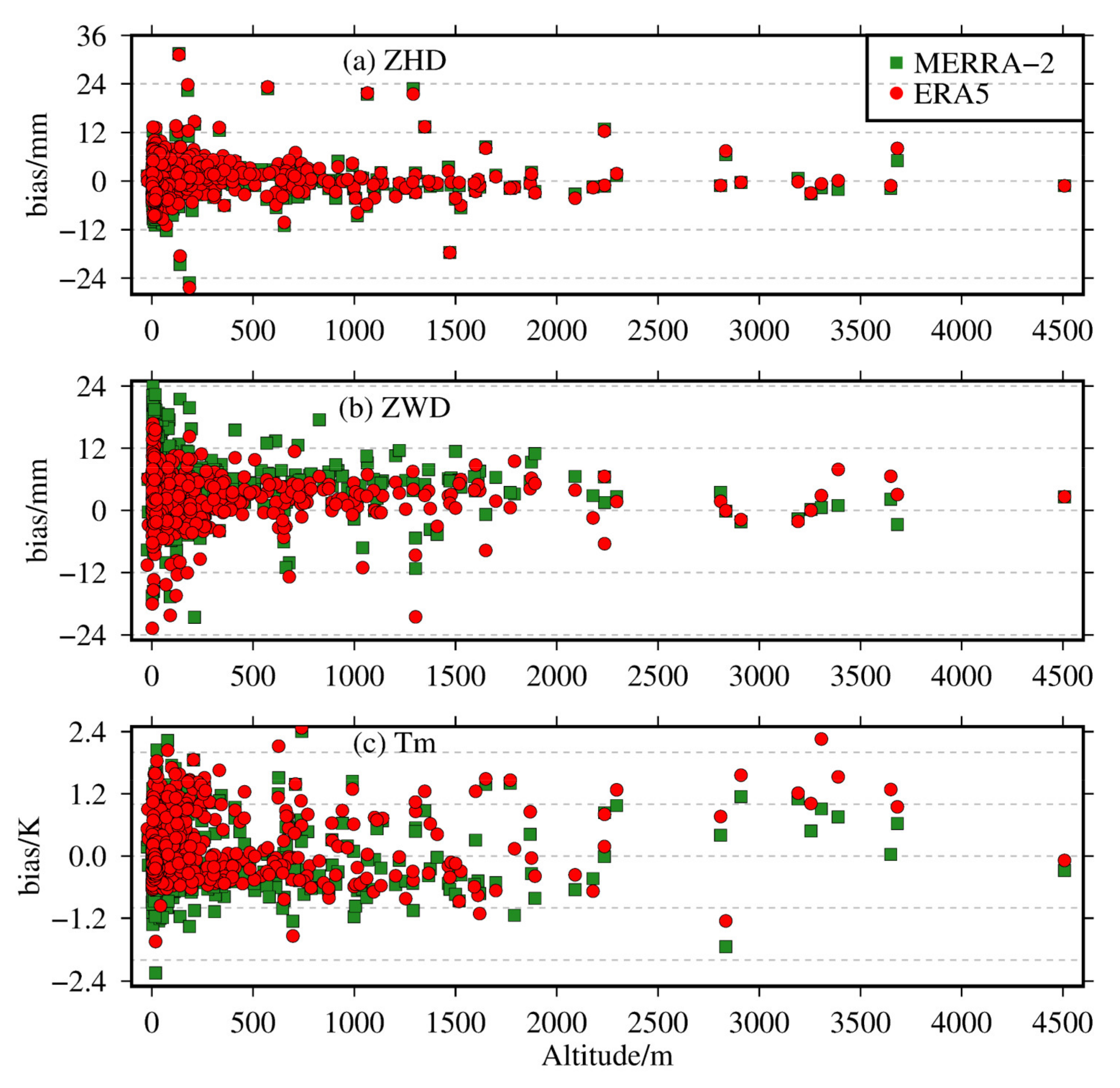
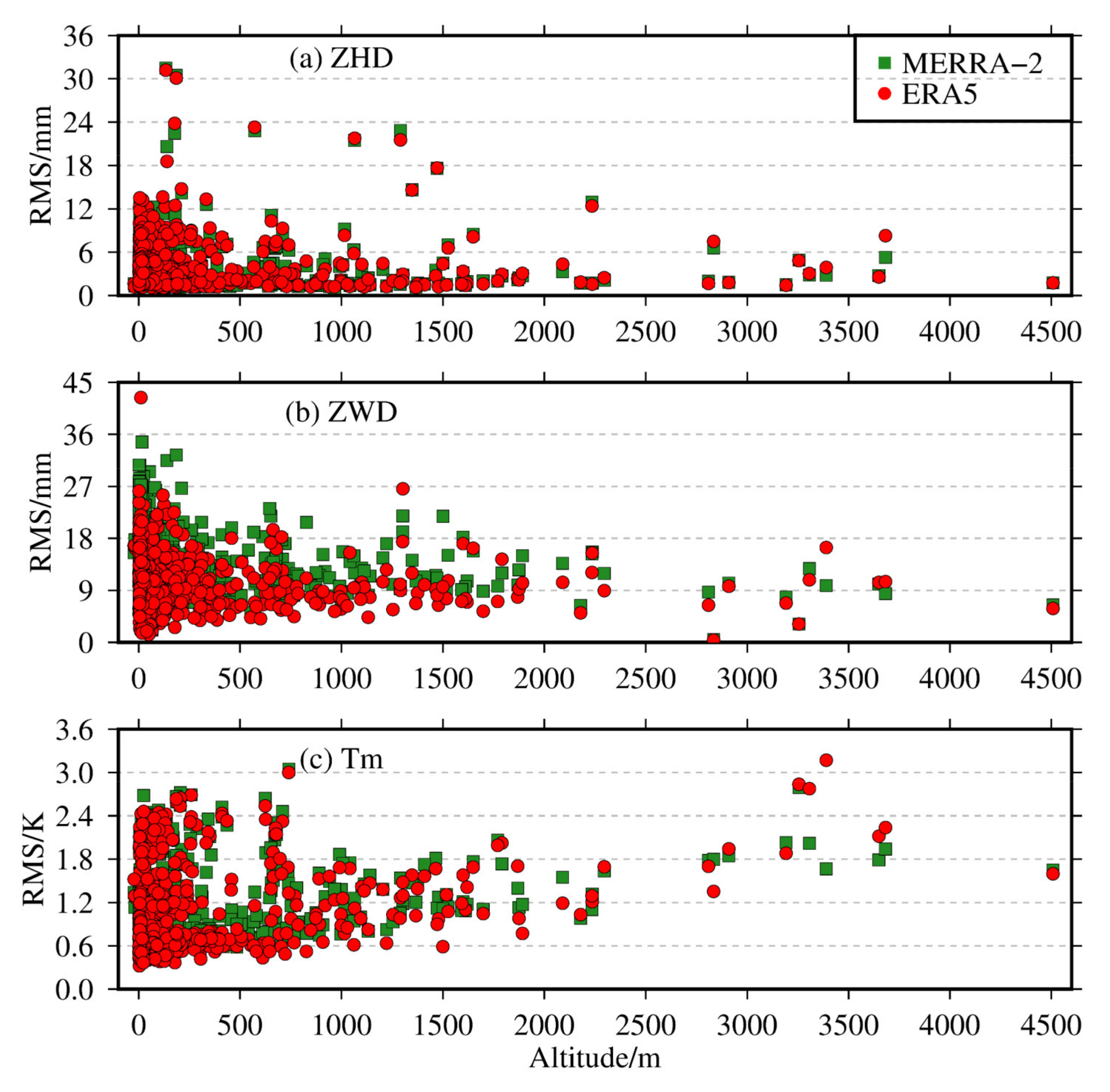
| MERRA-2 | ERA5 | |||||||
|---|---|---|---|---|---|---|---|---|
| Pressure-ZTD | Surface-ZTD | Pressure-ZTD | Surface-ZTD | |||||
| bias (mm) | RMS (mm) | bias (mm) | RMS (mm) | bias (mm) | RMS (mm) | bias (mm) | RMS (mm) | |
| Mean | 4.5 | 13.1 | −4.8 | 27.9 | 2.3 | 10.9 | 3.8 | 31.6 |
| Minimum | −12.8 | 4.0 | −72.8 | 10.5 | −15.8 | 3.9 | −59.8 | 14.6 |
| Maximum | 23.4 | 25.1 | 45.8 | 75.0 | 21.3 | 24.2 | 59.8 | 65.1 |
| Northern Hemisphere | Southern Hemisphere | |||||||
|---|---|---|---|---|---|---|---|---|
| MERRA-2 | ERA5 | MERRA-2 | ERA5 | |||||
| bias (mm) (cm) | RMS (mm) | bias (mm) | RMS (mm) | bias (mm) | RMS (mm) | bias (mm) | RMS (mm) | |
| Spring | 5.1 | 12.3 | 2.2 | 9.7 | 2.5 | 14.4 | 0.3 | 12.1 |
| Summer | 8.0 | 16.4 | 3.2 | 13.1 | 2.7 | 12.2 | 0.9 | 10.8 |
| Autumn | 4.9 | 12.4 | 3.1 | 10.4 | 1.5 | 13.3 | 0 | 11.3 |
| Winter | 2.8 | 9.6 | 2.8 | 8.5 | 2.0 | 16.1 | 0 | 13.1 |
| GNSS Station | Latitude/° | Longitude/° | Altitude/m | Special Features |
|---|---|---|---|---|
| thu2 | 76.54N | 68.82W | 36.1 | - |
| shao | 31.1N | 121.2E | 22.1 | along the coastline |
| lhaz | 29.66N | 91.1E | 3622 | high altitude |
| cnmr | 15.23N | 145.74E | 64.4 | equatorial region |
| samo | 13.85S | 171.7W | 76.9 | equatorial region |
| mgue | 35.78S | 69.4W | 1554.2 | high altitude and near the coastline |
| wgtn | 41.32S | 174.81E | 26.1 | along the coastline |
| maw1 | 67.6S | 62.87E | 59.2 | - |
| MERRA-2 | ERA5 | ||||
|---|---|---|---|---|---|
| bias | RMS | bias | RMS | ||
| ZHD (mm) | Mean | 0.5 | 4.4 | 1.1 | 4.5 |
| Minimum | −25.1 | 1.1 | −26.3 | 1.1 | |
| Maximum | 31.5 | 31.5 | 31.2 | 31.2 | |
| ZWD (mm) | Mean | 4.8 | 13.6 | 1.7 | 10.5 |
| Minimum | −20.6 | 0.5 | −22.7 | 0.4 | |
| Maximum | 25.8 | 34.7 | 26.6 | 42.3 | |
| Tm (K) | Mean | −0.08 | 1.17 | 0.14 | 1.03 |
| Minimum | −2.25 | 0.50 | −1.65 | 0.32 | |
| Maximum | 2.40 | 3.04 | 2.47 | 3.17 | |
| Northern Hemisphere | Southern Hemisphere | ||||||||
|---|---|---|---|---|---|---|---|---|---|
| MERRA-2 | ERA5 | MERRA-2 | ERA5 | ||||||
| bias | RMS | bias | RMS | bias | RMS | bias | RMS | ||
| ZHD (mm) | Spring | 1.1 | 4.5 | 1.6 | 4.6 | −2.1 | 5.1 | −1.2 | 4.6 |
| Summer | 0.7 | 4.1 | 1.3 | 4.3 | −2.1 | 5.3 | −1.1 | 4.7 | |
| Autumn | 1.0 | 4.5 | 1.7 | 4.7 | −2.4 | 5.2 | −1.4 | 4.7 | |
| Winter | 1.2 | 4.1 | 1.9 | 4.3 | −2.3 | 5.0 | −1.5 | 4.6 | |
| ZWD (mm) | Spring | 4.5 | 12.6 | 1.7 | 9.9 | 8.3 | 17.1 | 2.9 | 11.2 |
| Summer | 8.8 | 19.1 | 2.9 | 14.8 | 7.4 | 14.6 | 2.7 | 9.7 | |
| Autumn | 3.3 | 12.5 | 1.1 | 10.3 | 8.8 | 16.6 | 4.4 | 11.1 | |
| Winter | 0.7 | 8.0 | 0.3 | 6.6 | 9.2 | 18.8 | 4.0 | 12.3 | |
| Tm (K) | Spring | 0.07 | 1.31 | 0.2 | 1.19 | −0.58 | 0.95 | −0.21 | 0.62 |
| Summer | −0.22 | 1.18 | 0.09 | 1.05 | −0.62 | 1.01 | −0.3 | 0.7 | |
| Autumn | −0.03 | 1.17 | 0.21 | 1.06 | −0.56 | 0.99 | −0.19 | 0.67 | |
| Winter | 0.17 | 1.18 | 0.28 | 1.09 | −0.52 | 0.95 | −0.09 | 0.64 | |
Publisher’s Note: MDPI stays neutral with regard to jurisdictional claims in published maps and institutional affiliations. |
© 2021 by the authors. Licensee MDPI, Basel, Switzerland. This article is an open access article distributed under the terms and conditions of the Creative Commons Attribution (CC BY) license (https://creativecommons.org/licenses/by/4.0/).
Share and Cite
Guo, L.; Huang, L.; Li, J.; Liu, L.; Huang, L.; Fu, B.; Xie, S.; He, H.; Ren, C. A Comprehensive Evaluation of Key Tropospheric Parameters from ERA5 and MERRA-2 Reanalysis Products Using Radiosonde Data and GNSS Measurements. Remote Sens. 2021, 13, 3008. https://doi.org/10.3390/rs13153008
Guo L, Huang L, Li J, Liu L, Huang L, Fu B, Xie S, He H, Ren C. A Comprehensive Evaluation of Key Tropospheric Parameters from ERA5 and MERRA-2 Reanalysis Products Using Radiosonde Data and GNSS Measurements. Remote Sensing. 2021; 13(15):3008. https://doi.org/10.3390/rs13153008
Chicago/Turabian StyleGuo, Lijie, Liangke Huang, Junyu Li, Lilong Liu, Ling Huang, Bolin Fu, Shaofeng Xie, Hongchang He, and Chao Ren. 2021. "A Comprehensive Evaluation of Key Tropospheric Parameters from ERA5 and MERRA-2 Reanalysis Products Using Radiosonde Data and GNSS Measurements" Remote Sensing 13, no. 15: 3008. https://doi.org/10.3390/rs13153008
APA StyleGuo, L., Huang, L., Li, J., Liu, L., Huang, L., Fu, B., Xie, S., He, H., & Ren, C. (2021). A Comprehensive Evaluation of Key Tropospheric Parameters from ERA5 and MERRA-2 Reanalysis Products Using Radiosonde Data and GNSS Measurements. Remote Sensing, 13(15), 3008. https://doi.org/10.3390/rs13153008







